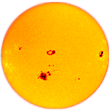That Lucky Old Sun (Idle Words)#
11.10.2003
Longtime readers of this site will know that I'm a sucker for dangers outside the realm of ordinary experience. Whether it be comet impact, devastating hyperfloods, giant killer earthquakes, enormous creatures underneath the sea, the failure of the Atlantic conveyor, evil undead food crops, megatsunamis destroying the East Coast, or biosphere-devouring nanotechnology, you're likely to find me worrying about it on this site, whose last post will read "I... told... you... so".

So imagine my delight last week when the Sun started going crazy, producing not one, not two... but a whole string of enormous flares, including the Nov. 4 behemoth that broke all previous records. Several of these hit our planet head-on, disrupting a few satellites and exposing airline passengers at high latitudes to the equivalent of a chest X-ray. It was double the pleasure for me - not only was there the Terror From Above thrill, but I also happen to live at a decent latitude, so any coronal mass ejection (oh yeah, baby!) means the chance of seeing beautiful aurora.
With all the activity, I found myself spending a lot of time on the Space Weather website, which is a great place to go if you want to know whether to look up on any particular night. SpaceWeather covers flares, meteor showers, eclipses, aurora, and even has a handy table of recent Earth-asteroid encounters for the truly anxious.
I also became a regular visitor to the NOAA's Auroral Northern Hemisphere map, which shows auroral activity in near-real time, so you can tell if it's worth going out to stare at the horizon. Auroras are always present, in an oval whose southernmost point is roughly opposite to the noonday sun, but their extent and intensity varies widely depending on a bazillion factors, all of which you can read about on the University of Alaska's Aurora FAQ. As if there weren't enough reasons to like Canada, it's one of the best places to consistently see aurora - while Europe is at a similar geographic latitude, the Canadians have the north magnetic pole in their (enormous) backyard, so their magnetic latitude is higher. That means more light shows.
All of this solar commotion comes on the downhill part of the 11-year sunspot cycle, during which the sun breaks out in spots, and then clears up again. A little rooting around led me to NASA's Solar Physics website, which is yet another one of those outstanding uses of the web that government agencies seem so mysteriously competent at creating. The site is pitched exactly right - it assumes you know some physics and astronomy, unlike many "Did You Know?" CNN-style explainer sites - and it includes some amazing solar eye candy for people with broadband. But the substantive part is just as impressive. I tend to assume that what I learned in high school and college is roughly what is known today, forgetting that fields like solar physics (and cosmology, and so much else) have been totally revolutionized over the past ten years thanks to space probes and computer modeling.
So there was plenty on the site to make my jaw drop. Most amazing was the fact that the Sun is filled with reflecting sound waves. The entire surface of the star oscillates up and down in California-sized pieces, moving at roughly a five minute cycle. The sound waves come from hypersonic convection currents (!) in the outer layer of the star, and are trapped within. Here's what the sun sounds like, courtesy of Stanford's Solar Sounds page (something nice for the linkbar).
Not only is the Sun pulsing with such trapped sound waves, but they enable scientists to do actual imaging of the far side of the Sun, by looking at interference patterns and other such in the bouncy waves. Again, do not attempt this without a computer. You can see a nice plot of the Sun's nether side (which should soon be showing those big fat sunspots that clobbered us last week) on the SpaceWeather.com homepage.
A little digging around on the solar sites unearthed a nice mystery for the disaster-seeking part of my brain. It turns out there is a period from 1645 to 1715 called the Maunder Minimum, during which there are almost no records of sunspot activity, and the reports of aurora go way down. Intriguingly, this period falls right in the middle of the Little Ice Age, a period from c. 1350 to c. 1850 in which Europe and North America experienced much harsher winters than at present. This leads some scientists to posit a link between solar activity and our own climate. Given the commotion over Kyoto and greenhouse gasses, it would be very significant if the Sun turned out to be in charge of the global thermostat.
If I were in charge of the global thermostat, everyone would be freezing.
"Do you realize what it costs to heat this place?"